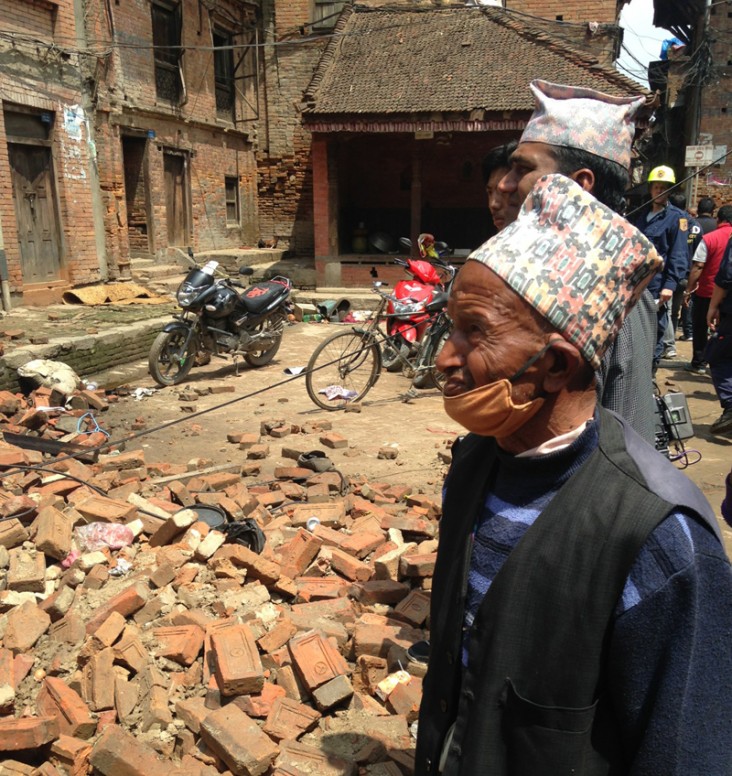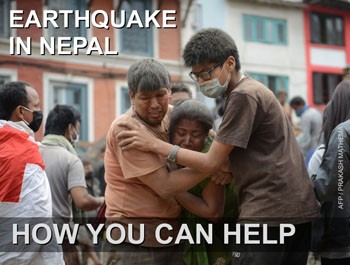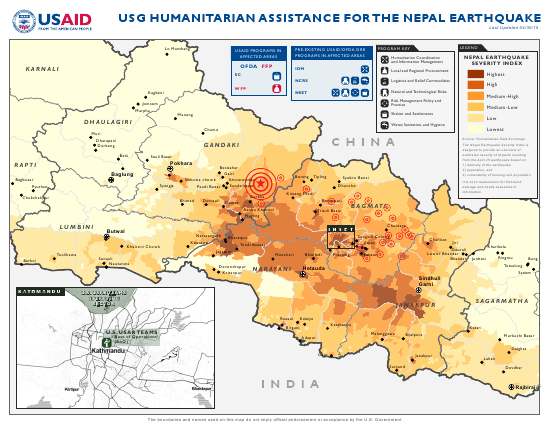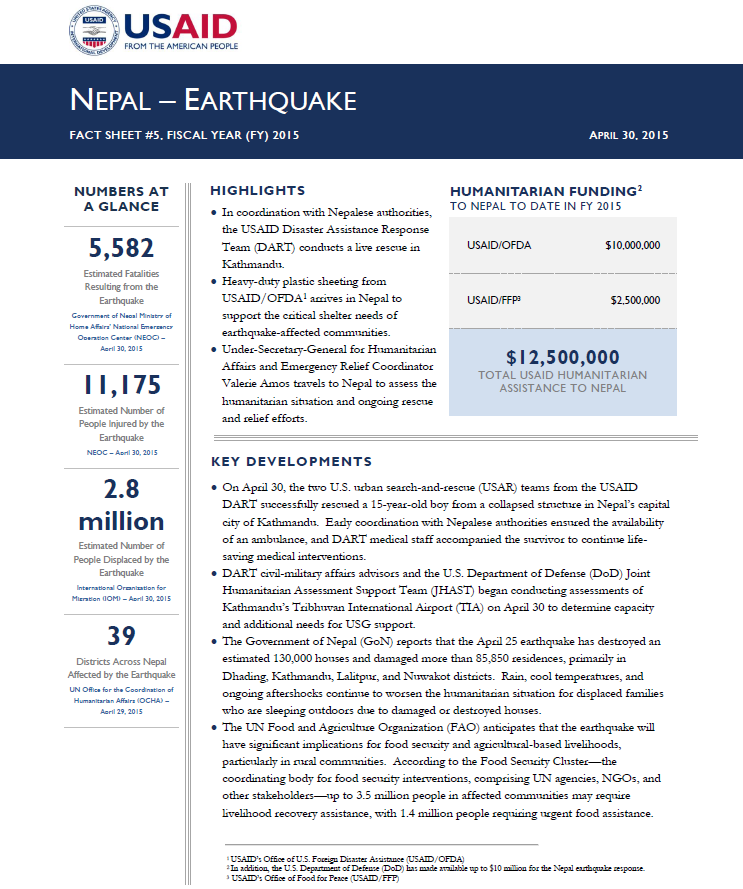Speeches Shim
April 30, 2015
Highlights
In coordination with Nepalese authorities, the USAID Disaster Assistance Response Team (DART) conducts a live rescue in Kathmandu.
Heavy-duty plastic sheeting from USAID/OFDA arrives in Nepal to support the critical shelter needs of earthquake-affected communities.
Under-Secretary-General for Humanitarian Affairs and Emergency Relief Coordinator Valerie Amos travels to Nepal to assess the humanitarian situation and ongoing rescue and relief efforts.
Key Developments
Nepal Earthquake Map - April 30, 2015 ![]() (pdf - 2 MB)
(pdf - 2 MB)
Numbers At A Glance
5,582
11,175
2.8 million
39
Humanitarian Funding:
To Nepal To Date In FY2015:
| USAID/OFDA | $10,000,000 |
| USAID/FFP | $2,500,000 |
| TOTAL | $12,500,000 |
In addition, the U.S. Department of Defense (DoD) has made available up to $10 million for the Nepal earthquake response.
Nepal Earthquake Fact Sheet #5 - 04-30-2015 ![]() (pdf - 184k)
(pdf - 184k)
On April 30, the two U.S. urban search-and-rescue (USAR) teams from the USAID DART successfully rescued a 15-year-old boy from a collapsed structure in Nepal’s capital city of Kathmandu. Early coordination with Nepalese authorities ensured the availability of an ambulance, and DART medical staff accompanied the survivor to continue life-saving medical interventions.
DART civil-military affairs advisors and the U.S. Department of Defense (DoD) Joint Humanitarian Assessment Support Team (JHAST) began conducting assessments of Kathmandu’s Tribhuvan International Airport (TIA) on April 30 to determine capacity and additional needs for USG support.
The Government of Nepal (GoN) reports that the April 25 earthquake has destroyed an estimated 130,000 houses and damaged more than 85,850 residences, primarily in Dhading, Kathmandu, Lalitpur, and Nuwakot districts. Rain, cool temperatures, and ongoing aftershocks continue to worsen the humanitarian situation for displaced families who are sleeping outdoors due to damaged or destroyed houses.
The UN Food and Agriculture Organization (FAO) anticipates that the earthquake will have significant implications for food security and agricultural-based livelihoods, particularly in rural communities. According to the Food Security Cluster—the coordinating body for food security interventions, comprising UN agencies, NGOs, and other stakeholders—up to 3.5 million people in affected communities may require livelihood recovery assistance, with 1.4 million people requiring urgent food assistance.
USAR AND LOGISTICS
International USAR teams are continuing to conduct search-and-rescue operations in Kathmandu. On April 30, USAID DART’s USAR teams from Fairfax County, Virginia, and Los Angeles County, California, successfully rescued a 15-year-old boy from a collapsed structure.
As of April 29, national and international rescue operations were underway in nine districts, including Bhaktapur, Dhading, Gorkha, Kathmandu, Kavrepalanchowk, Lalitpur, Nuwakot, Rasuwa, and Sindhupalchowk, the UN reports. Rescue operations beyond Kathmandu Valley, however, are limited due to debris, access challenges, and damage to communication infrastructure. The UN Office of the Resident Coordinator (ORC) reports that top priorities of the GoN and humanitarian partners moving forward will shift from search-and rescue to dead body management, the identification of missing people, and family reunifications.
SHELTER
NEOC estimates that the earthquake destroyed more than 130,000 houses and damaged more than 85,850 residences, primarily in Dhading, Kathmandu, Lalitpur, and Nuwakot districts. In addition, NEOC reports significant damage or destruction to more than 23,500 GoN buildings. According to the ORC, structural vulnerability assessments of damaged buildings are needed to determine whether it is safe for families to begin returning to their homes.
To address critical shelter needs, 700 rolls of USAID/OFDA heavy-duty plastic sheeting arrived in Kathmandu on April 30. USAID/OFDA partner IOM plans to distribute the plastic sheeting to approximately 3,500 earthquake-affected households—or up to 17,500 people—along with additional IOM supplies, including rope, wire, and basic hand tools.
On April 29, USAID/OFDA—through USAID/Nepal—committed $1 million to Save the Children (SC) to address immediate shelter and water, sanitation, and hygiene (WASH) needs in urban and rural communities in the most-affected districts in Nepal. A longtime USAID partner, SC has implemented WASH, nutrition, and food security activities across the country, including in some of the areas hardest-hit by the recent earthquake. Through its experience, SC has developed robust local networks and is well-situated to quickly and efficiently distribute emergency relief supplies to hard-to-reach affected areas.
DISPLACEMENT

The Kathmandu Valley currently hosts 16 GoN-identified camps for internally displaced persons (IDPs) in Bhaktapur, Lalitpur, and Kathmandu districts. Approximately 24,000 people are currently sheltering in 13 of these sites, according to the Camp Coordination and Camp Management (CCCM) Cluster. The number of IDPs reflects a decrease from the more than 70,000 people who were sheltering in these and other open spaces in the immediate aftermath of the earthquake. Relief actors report that many families are returning to their houses and villages, and the residual camp populations are primarily people whose houses were destroyed or renters who have lost their income and can no longer pay rent. Preliminary CCCM surveys indicate that other IDPs are apprehensive about returning home due to cracks in their buildings and corpses in the streets.
USAID/OFDA partner the Nepal Red Cross Society (NRCS) is distributing pre-positioned emergency relief items to approximately 3,000 families in the earthquake-affected districts of Bhaktapur, Kathmandu, Lalitpur, Rasuwa, Sindhupalchowk, and Syangja. The relief items, which include blankets, clothing, kitchen utensils, and water containers, are also reaching vulnerable populations in the IDP camps established in Kathmandu Valley.
HEALTH
The GoN and other response actors have highlighted the urgency of providing medical resources in areas outside of Kathmandu Valley. The GoN Ministry of Health and Population, in coordination with the UN World Health Organization (WHO), plans to begin identifying in-country foreign medical teams (FMTs) that may be able to offer continued medical support in areas beyond Kathmandu following the immediate response. At present, OCHA reports that more than 30 FMTs—comprising a total of 365 personnel—are providing health services and medical supplies in Nepal, including medical treatment and hygiene promotion activities.
FOOD SECURITY
USAID’s Office of Food for Peace (USAID/FFP) has contributed $2.5 million to WFP’s Corporate Response Emergency Operation for the purchase of 1,390 metric tons (MT) of rice to address the urgent food needs of approximately 120,000 people for one month. The Food Security Cluster estimates that 1.4 million earthquake-affected people require food assistance during the next three months.
The FAO anticipates a significant impact on food security and livelihoods due to disruptions to the agricultural planting season—which is expected to begin in late May—as well as the likely loss of livestock, food supplies, and agricultural inputs following the earthquake. As of April 30, FAO had requested $8 million to provide Nepalese farmers with key agricultural inputs needed to resume preparations for rice sowing season, as well as animal feed and veterinary services to maintain remaining livestock.
CONTEXT
On April 25, a magnitude 7.8 earthquake struck central Nepal at a shallow depth of approximately 15 kilometers (km), according to the USGS. The epicenter of the earthquake was located approximately 77 km northwest of Kathmandu, the country’s capital city, and 73 km east of Pokhara, another major city in central Nepal.
The USG immediately issued a disaster declaration for Nepal due to the effects of the earthquake. Within hours of the seismic event, USAID/OFDA had activated a RMT in Washington, D.C., and deployed a DART—including USAR specialists—to support emergency response efforts in Nepal.
For nearly two decades, USAID/OFDA has supported disaster risk reduction (DRR) efforts in Nepal, including throughout Kathmandu Valley. USAID/OFDA funding has enabled the International Organization for Migration (IOM) to identify, prepare, and preserve more than 80 open spaces in Kathmandu Valley to ensure the sites are available for humanitarian purposes—such as distribution centers or warehouses—in the event of large-scale disasters. USAID/OFDA has also supported NRCS to pre-position critical emergency relief supplies in order to address the immediate needs of affected communities following a disaster.
Through the Kathmandu-based National Society for Earthquake Technology (NSET), USAID/OFDA is strengthening Nepal’s earthquake response capacity by institutionalizing DRR at the local and national levels in collaboration with the GoN, non-governmental organizations, schools, and local communities. With USAID/OFDA support, NSET is also promoting public-private partnerships for earthquake risk management and enhancing the capacity of municipal governments to develop and administer building code permits and control systems to better protect against seismic activity.
PUBLIC DONATION INFORMATION
The most effective way people can assist relief efforts is by making cash contributions to humanitarian organizations that are conducting relief operations. A list of humanitarian organizations that are accepting cash donations for disaster responses around the world can be found at www.interaction.org.
USAID encourages cash donations because they allow aid professionals to procure the exact items needed (often in the affected region); reduce the burden on scarce resources (such as transportation routes, staff time, and warehouse space); can be transferred very quickly and without transportation costs; support the economy of the disaster-stricken region; and ensure culturally, dietary, and environmentally appropriate assistance.
More information can be found at:
- The Center for International Disaster Information: www.cidi.org or +1.202.821.1999.
-
Information on relief activities of the humanitarian community can be found at www.reliefweb.int.




Comment
Make a general inquiry or suggest an improvement.